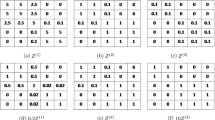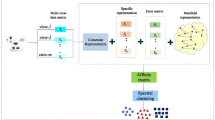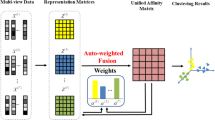Abstract
Multi-view subspace clustering aims to classify a collection of multi-view data drawn from a union of subspaces into their corresponding subspaces. Though existing methods generally make promising performance, fully making use of the diversity and consistency of multiple information leaves space for further improvement of the clustering results. In this paper, we explore two new constraints: inter-cluster consistency among views (ICAV) and intra-cluster diversity among views (IDAV). Based on IDAV, we propose a new regularization term which couples the intra-cluster self-representation matrix and the label indicator matrix. This new regularization term tends to enforce the self-representation coefficients from the same subspace of different views highly uncorrelated. A technique similar to Exclusivity-Consistency Regularized Multi-view Subspace Clustering (ECMSC) is also used to enforce ICAV of self-representation coefficients. Further, we formulate them into a unified model and call it Multi-view Subspace Clustering with Inter-cluster Consistency and Intra-cluster Diversity among views (MSC-ICID). Based on the alternating minimization method, an efficient algorithm is proposed to solve the new model. We evaluate our method using several metrics and compare it with several state-of-the-art methods on some commonly used datasets. The results demonstrate that our method outperforms the state-of-the-art methods in the vast majority of metrics.









Similar content being viewed by others
Notes
References
Benton A, Khayrallah H, Gujral B, Reisinger DA, Zhang S, Arora R (2019) Deep generalized canonical correlation analysis. In: Proceedings of the Workshop on Representation Learning for NLP, pp 1–6
Boyd S, Parikh N, Chu E, Peleato B, Eckstein J et al (2011) Distributed optimization and statistical learning via the alternating direction method of multipliers. Foundations and Trends®, in Machine learning 3(1):1–122
Cao X, Zhang C, Fu H, Liu S, Zhang H (2015) Diversity-induced multi-view subspace clustering. In: Proceedings of the IEEE Conference on Computer Vision and Pattern Recognition, pp 586–594
Chen H, Wang W, Feng X (2018a) Structured sparse subspace clustering with grouping-effect-within-cluster. Pattern Recogn 83:107–118
Chen H, Wang W, Feng X, He R (2018b) Discriminative and coherent subspace clustering. Neurocomputing 284:177–186
Chen MS, Huang L, Wang CD, Huang D, Philip SY (2020) Multiview subspace clustering with grouping effect. IEEE Transactions on Cybernetics
Chen Y, Wang S, Zheng F, Cen Y (2020) Graph-regularized least squares regression for multi-view subspace clustering. Knowl-Based Syst 194:105482
Elhamifar E, Vidal R (2013) Sparse subspace clustering: Algorithm, theory, and applications. IEEE Transactions on Pattern Analysis and Machine Intelligence 35(11):2765–2781
Hayashi T, Fujita H, Hernandez-Matamoros A (2021) Less complexity one-class classification approach using construction error of convolutional image transformation network. Inf Sci 560:217–234
Huang S, Kang Z, Xu Z (2018) Self-weighted multi-view clustering with soft capped norm. Knowl-Based Syst 158:1–8
Kang Z, Shi G, Huang S, Chen W, Pu X, Zhou JT, Xu Z (2020) Multi-graph fusion for multi-view spectral clustering. Knowl-Based Syst 189:105102
Kang Z, Zhao X, Peng C, Zhu H, Zhou JT, Peng X, Chen W, Xu Z (2020b) Partition level multiview subspace clustering. Neural Netw 122:279–288
Li CG, Vidal R (2016) A structured sparse plus structured low-rank framework for subspace clustering and completion. IEEE Transactions on Signal Processing 64(24):6557–6570
Li CG, You C, Vidal R (2017) Structured sparse subspace clustering: a joint affinity learning and subspace clustering framework. IEEE Trans Image Process 26(6):2988–3001
Li H, Ren Z, Mukherjee M, Huang Y, Sun Q, Li X, Chen L (2020) Robust energy preserving embedding for multi-view subspace clustering. Knowl-Based Syst 210:106489
Liang W, Zhou S, Xiong J, Liu X, Wang S, Zhu E, Cai Z, Xu X (2020) Multi-view spectral clustering with high-order optimal neighborhood laplacian matrix. IEEE Transactions on Knowledge and Data Engineering
Liu G, Lin Z, Yan S, Sun J, Yu Y, Ma Y (2012) Robust recovery of subspace structures by low-rank representation. IEEE Transactions on Pattern Analysis and Machine Intelligence 35(1):171–184
Liu J, Liu X, Xiong J, Liao Q, Zhou S, Wang S, Yang Y (2020) Optimal neighborhood multiple kernel clustering with adaptive local kernels. IEEE Transactions on Knowledge and Data Engineering
Liu J, Liu X, Yang Y, Guo X, Kloft M, He L (2021) Multiview subspace clustering via co-training robust data representation. IEEE Transactions on Neural Networks and Learning Systems
Liu M, Wang Y, Sun J, Ji Z (2020) Structured block diagonal representation for subspace clustering. Appl Intell 50(8):2523–2536
Lu C, Feng J, Lin Z, Mei T, Yan S (2018) Subspace clustering by block diagonal representation. IEEE Transactions on Pattern Analysis and Machine Intelligence 41(2):487–501
Luo S, Zhang C, Zhang W, Cao X (2018) Consistent and specific multi-view subspace clustering. In: Thirty-Second AAAI Conference on Artificial Intelligence
Niu D, Dy JG, Jordan MI (2013) Iterative discovery of multiple alternativeclustering views. IEEE Transactions on Pattern Analysis and Machine Intelligence 36(7):1340–1353
Shi J, Malik J (2000) Normalized cuts and image segmentation. IEEE Transactions on Pattern Analysis and Machine Intelligence 22(8):888–905
Tao H, Hou C, Qian Y, Zhu J, Yi D (2020) Latent complete row space recovery for multi-view subspace clustering. IEEE Trans Image Process 29:8083–8096
Vidal R (2011) Subspace clustering. IEEE Signal Proc Mag 28(2):52–68
Wang CD, Chen MS, Huang L, Lai JH, Philip SY (2020) Smoothness regularized multiview subspace clustering with kernel learning. IEEE Transactions on Neural Networks and Learning Systems
Wang H, Yang Y, Liu B, Fujita H (2019) A study of graph-based system for multi-view clustering. Knowl-Based Syst 163:1009–1019
Wang X, Guo X, Lei Z, Zhang C, Li SZ (2017) Exclusivity-consistency regularized multi-view subspace clustering. In: Proceedings of the IEEE Conference on Computer Vision and Pattern Recognition, pp 923–931
Wang X, Lei Z, Guo X, Zhang C, Shi H, Li SZ (2019) Multi-view subspace clustering with intactness-aware similarity. Pattern Recogn 88:50–63
Wang Y, Wu L, Lin X, Gao J (2018) Multiview spectral clustering via structured low-rank matrix factorization. IEEE transactions on neural networks and learning systems 29(10):4833–4843
Xiao Q, Dai J, Luo J, Fujita H (2019) Multi-view manifold regularized learning-based method for prioritizing candidate disease mirnas. Knowl-Based Syst 175:118–129
Xie X, Guo X, Liu G, Wang J (2018) Implicit block diagonal low-rank representation. IEEE Trans Image Process 27(1):477–489
Zhang C, Fu H, Liu S, Liu G, Cao X (2015) Low-rank tensor constrained multiview subspace clustering. In: Proceedings of the IEEE international conference on computer vision, pp 1582–1590
Zhang C, Hu Q, Fu H, Zhu P, Cao X (2017) Latent multi-view subspace clustering. In: Proceedings of the IEEE Conference on Computer Vision and Pattern Recognition, pp 4279–4287
Zhang C, Fu H, Hu Q, Cao X, Xie Y, Tao D, Xu D (2018) Generalized latent multi-view subspace clustering. IEEE Transactions on Pattern Analysis and Machine Intelligence 42(1):86–99
Zhang GY, Zhou YR, He XY, Wang CD, Huang D (2020) One-step kernel multi-view subspace clustering. Knowl-Based Syst 189:105126
Zhang GY, Zhou YR, Wang CD, Huang D, He XY (2021) Joint representation learning for multi-view subspace clustering. Expert Syst Appl 166:113913
Zhang X, Yang Y, Li T, Zhang Y, Wang H, Fujita H (2021) Cmc: a consensus multi-view clustering model for predicting alzheimer’s disease progression. Comput Methods Prog Biomed 199:105895
Zhang Y, Yang Y, Li T, Fujita H (2019) A multitask multiview clustering algorithm in heterogeneous situations based on lle and le. Knowl-Based Syst 163:776–786
Zheng Q, Zhu J, Li Z, Pang S, Wang J, Li Y (2020) Feature concatenation multi-view subspace clustering. Neurocomputing 379:89–102
Zhou T, Zhang C, Gong C, Bhaskar H, Yang J (2018) Multiview latent space learning with feature redundancy minimization. IEEE transactions on cybernetics 50(4):1655–1668
Zhou T, Zhang C, Peng X, Bhaskar H, Yang J (2019) Dual shared-specific multiview subspace clustering. IEEE Transactions on Cybernetics 50(8):3517–3530
Zhu W, Lu J, Zhou J (2019) Structured general and specific multi-view subspace clustering. Pattern Recogn 93:392–403
Acknowledgements
The authors would like to thank the anonymous reviewers for their considerations and suggestions.
Author information
Authors and Affiliations
Corresponding author
Additional information
Publisher’s note
Springer Nature remains neutral with regard to jurisdictional claims in published maps and institutional affiliations.
The work of Tai was supported by the startup grant at Hong Kong Baptist University grants RG(R)-RC/17-18/02-MATH, HKBU 12300819, NSF/RGC Grant N-HKBU214-19, ANR/RGC Joint Research Scheme (A-HKBU203-19) and RC-FNRA-IG/19-20/SCI/01. The work of Chen was supported by the Natural Science Foundation of Henan Province (no.212300410320). The work of Wang was supported by the National Natural Science Foundation of China (no.61972264) and the Natural Science Foundation of Guangdong Province (no.2019A1515010894)
Rights and permissions
About this article
Cite this article
Chen, H., Tai, X. & Wang, W. Multi-view subspace clustering with inter-cluster consistency and intra-cluster diversity among views. Appl Intell 52, 9239–9255 (2022). https://doi.org/10.1007/s10489-021-02895-1
Accepted:
Published:
Issue Date:
DOI: https://doi.org/10.1007/s10489-021-02895-1




